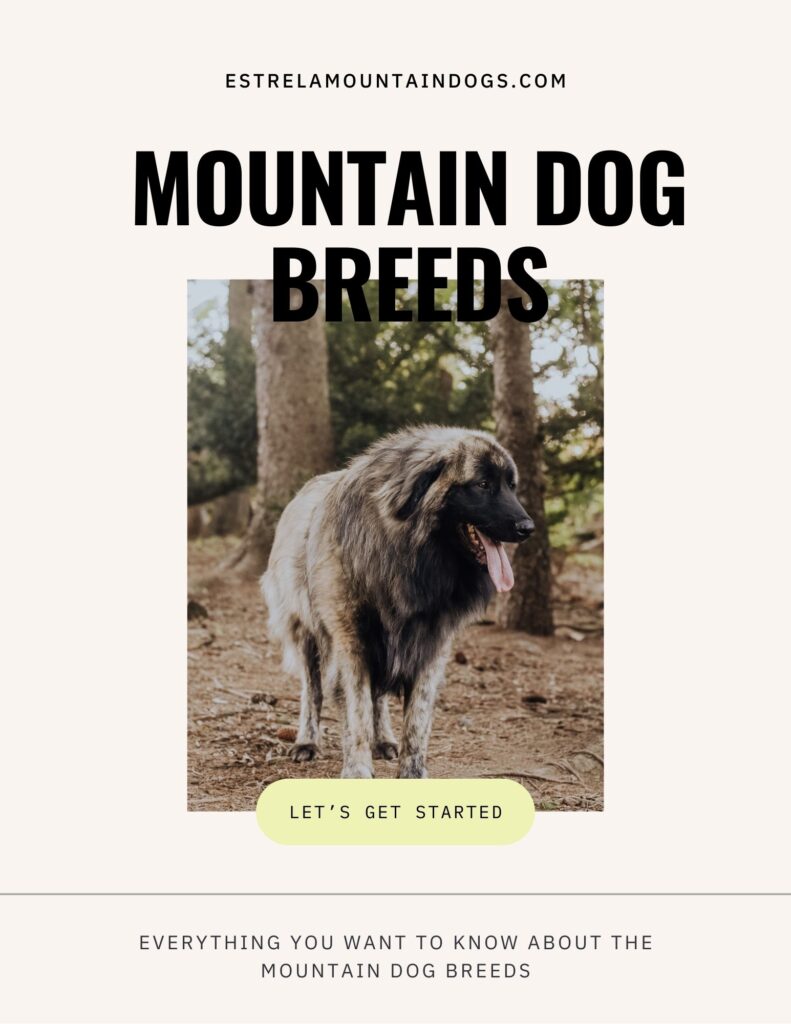
Mountain Dog Breeds: Are they for you?
Mountain dog breeds represent some of the most practical and historically important large dog breeds in the world. These dogs developed in the rugged environments of Europe’s mountain regions, where people relied on them for survival. Far from being ornamental, each of these livestock guardian dogs, draft dogs, or herding dogs was shaped by centuries of selection for endurance, weather resistance, and usefulness on farms and homesteads.
The term mountain dog brings together several distinct populations. While they share imposing size and loyalty, they differ in function, coat care, and health. The Estrela Mountain Dog of Portugal and the Pyrenean Mountain Dog (Great Pyrenees) remain true livestock guardian dogs, bred to protect flocks against predators such as wolves. The Bernese Mountain Dog and the Greater Swiss Mountain Dog, both from Switzerland, were originally farm helpers and draft dogs, pulling carts and guarding homesteads. The Appenzeller Mountain Dog and the Entlebucher Mountain Dog are smaller, agile cattle-driving and herding dogs, valued for their energy and resilience.
For anyone considering one of these large dog breeds, understanding the original purpose is critical. A dog developed for centuries as a livestock guardian will behave differently than one selected primarily as a farm companion or drover. Matching a breed’s historical role with a modern home, whether that is a working farm, a family in need of protection, or an active rural household, is the key to success.
This guide offers a complete comparison of all recognized mountain dog breeds, with emphasis on their health, lifespan, temperament, grooming needs, and working functions. By studying them side by side, prospective owners can evaluate which breed best fits their needs, whether they are searching for a dependable livestock guardian, a versatile farm dog, or a loyal large companion for family life.
Estrela Mountain Dog (Portugal)
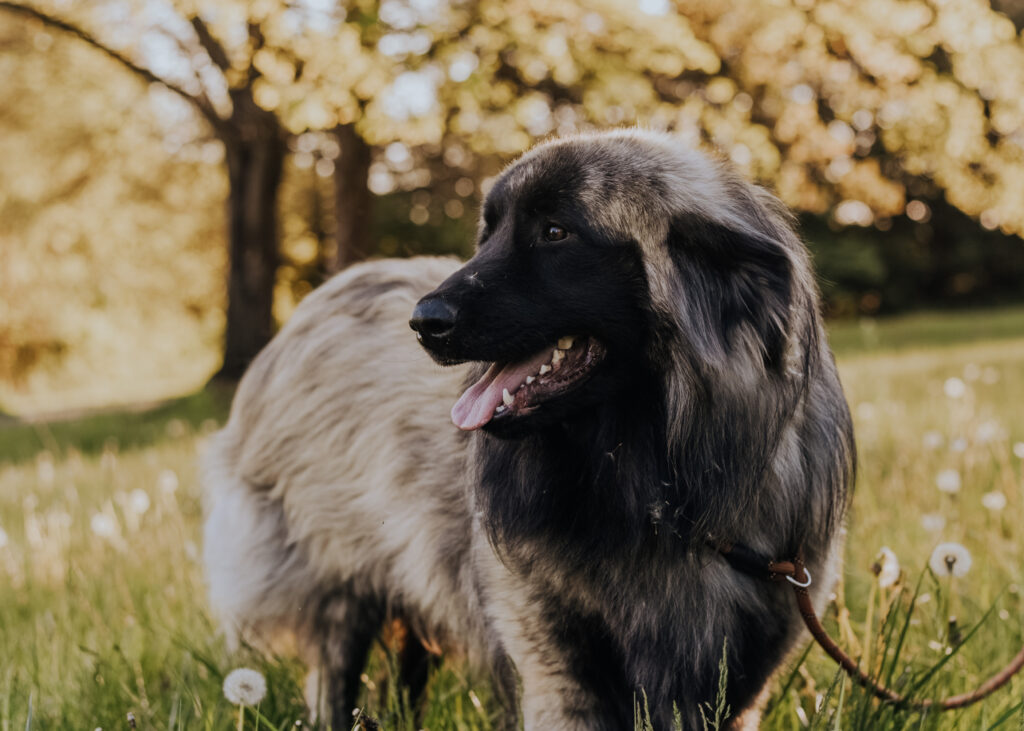
Estrela Mountain Dog History and Function
The Estrela Mountain Dog is among the oldest livestock guardian dogs still in existence. Originating in Portugal’s Serra da Estrela mountain range, this breed developed in a harsh environment where only the strongest, most capable dogs survived. Shepherds depended on them to guard flocks of sheep and goats from wolves, thieves, and other threats. Unlike herding breeds, Estrelas do not drive stock; instead, they remain with the animals, blending calm watchfulness with decisive action when danger arises.
Today, they continue to serve as reliable farm protection dogs while also gaining recognition as devoted family companions. Their deep loyalty, natural suspicion of strangers, and measured protectiveness make them a strong choice for households seeking both companionship and security.
Estrela Mountain Dog Size and Structure
Estrelas are a giant dog breed, with males typically weighing 100–130 pounds and females 90–115 pounds. They are substantial but balanced, built for endurance rather than speed. Their structure reflects their role: heavy bone, deep chest, and strong legs that allow them to patrol rough terrain with minimal fatigue. Unlike some modern giant breeds, the Estrela has not been exaggerated for show purposes, retaining the functional build that allowed it to thrive for centuries in the mountains.
Estrela Coat and Grooming
The Estrela’s coat is one of its defining features, providing protection against heat, cold, and wet conditions. There are two varieties:
- Long coat: Thick, abundant, and slightly coarse, forming a mane around the neck and feathering on the legs and tail.
- Short coat: Dense and smooth, with less feathering but equally weather-resistant.
Both require regular brushing to prevent mats and manage seasonal shedding. For working dogs kept outdoors, the coat is largely self-maintaining, but indoor companions benefit from weekly grooming. Bathing should be infrequent, as the natural oils protect the skin and coat.
Estrela Mountain Dog Temperament
True to its origins, the Estrela Mountain Dog is calm, loyal, and protective. These dogs form strong bonds with their families, often singling out one person as a special focus of devotion. They are independent thinkers, not eager to obey commands for the sake of it, but highly responsive when the task aligns with their protective instincts.
With children, they are typically gentle and watchful, though supervision is essential due to their size. With strangers, they remain aloof or suspicious, and early, consistent socialization is important to ensure confidence without unnecessary aggression.
Health and Lifespan
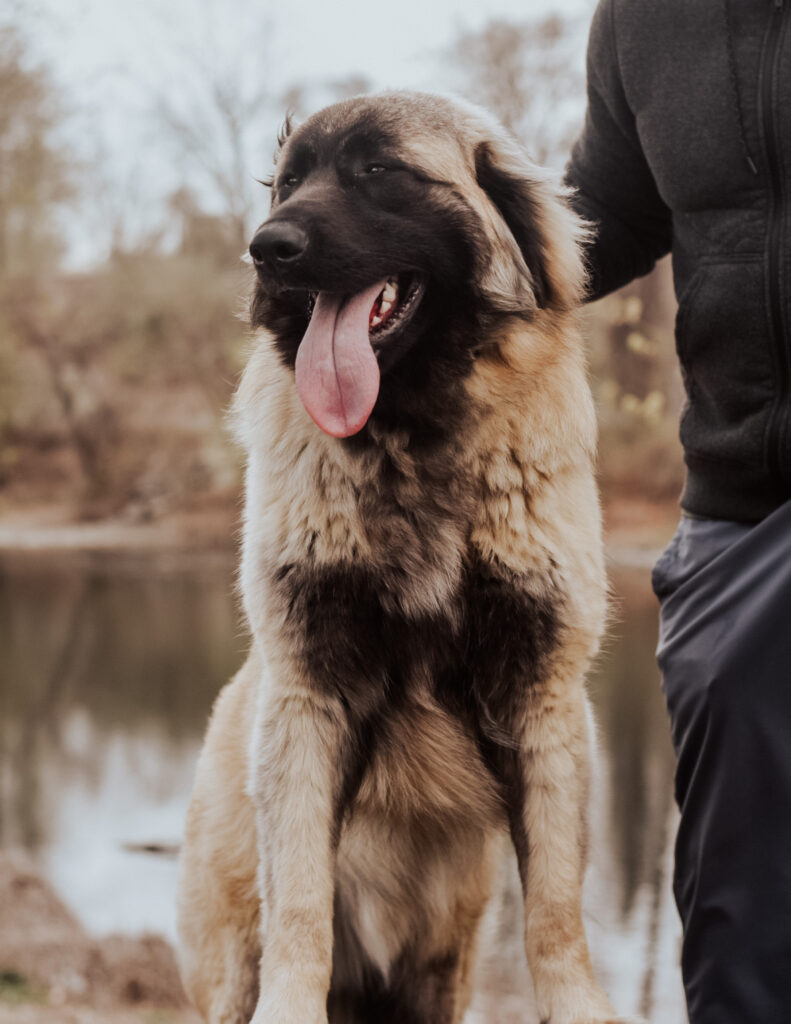
One of the strengths of the Estrela compared to many other giant breeds is its relative hardiness. Typical lifespan ranges from 10–12 years, longer than most dogs of similar size. The main health concerns are:
- Hip and elbow dysplasia (as with all large breeds)
- Entropion (a condition of the eyelids)
- Occasional bloat (gastric torsion), though less frequent than in some other guardian breeds
Responsible breeders screen for joint problems, and selective breeding has helped maintain the Estrela’s reputation for resilience. Compared to breeds like the Bernese Mountain Dog, the Estrela has a more favorable outlook, with fewer widespread issues of cancer or shortened lifespan.
Ideal Owner and Role
The Estrela Mountain Dog is not a breed for everyone. It thrives with owners who respect its guardian instincts and give it a meaningful role — whether that is guarding livestock, protecting property, or serving as a devoted family guardian. They are best suited to rural homes, farms, and experienced large-dog owners who can provide both structure and space. For the right household, the Estrela offers a rare combination: a guardian capable of real work and a family dog of deep loyalty and affection.
Estrela Mountain Dog FAQs
Do Estrela Mountain Dogs bark a lot?
Yes, Estrela Mountain Dogs are naturally vocal, a trait inherited from their centuries as livestock guardian dogs in Portugal. Barking was essential to warn off predators and alert shepherds to disturbances. In modern settings, this means they will sound the alarm at unusual noises or approaching strangers. With proper training and purposeful work, their barking can be managed, but it should never be expected to disappear entirely — it is part of their genetic function as a guardian breed.
Are Estrela Mountain Dogs good with children?
When raised in the right environment, Estrelas are often excellent with children. Their protective instincts extend naturally to young family members, and they are typically gentle, patient, and watchful. However, due to their large size and strong guarding drive, they require supervision, structure, and early socialization. Families should not rely solely on instinct; children must be taught to respect the dog’s boundaries, and the Estrela must be guided in how to interact appropriately.
How much exercise do Estrela Mountain Dogs need?
Despite their large size, Estrelas are not high-energy dogs. They are bred for endurance and steady work, not speed or constant motion. Daily walks, free movement in a secure yard, and meaningful jobs — such as guarding livestock or property — are sufficient. They do not thrive in apartments or highly urban environments, where their need for purposeful activity cannot be met.
How much grooming do Estrela Mountain Dogs require?
Both the long-coated and short-coated varieties of the Estrela Mountain Dog are relatively low-maintenance compared to some large breeds. Weekly brushing is usually enough to keep the coat healthy and to manage shedding. During seasonal coat changes, more frequent grooming may be needed. Their coat is naturally protective, so bathing should be occasional and only when necessary, to preserve the coat’s oils.
What is the lifespan of an Estrela Mountain Dog?
The Estrela Mountain Dog has a life expectancy of 10–12 years, which is longer than many other giant breeds. This relative longevity is one of the breed’s advantages. Health concerns include hip and elbow dysplasia, DCM, and occasional cases of gastric torsion (bloat). Compared with other large mountain dog breeds, Estrelas are regarded as hardy, resilient, and less prone to widespread genetic disease.
Are Estrela Mountain Dogs good family protection dogs?
Yes, Estrelas are deeply loyal to their families and naturally protective. They will typically act as a deterrent simply by their presence and confident posture. They are not indiscriminate guard dogs, however; they combine suspicion of strangers with measured responses, preferring to warn before acting. This balance of loyalty, protectiveness, and sound judgment is one of the reasons the Estrela is considered one of the best farm and family protection dogs.
Bernese Mountain Dog (Switzerland)
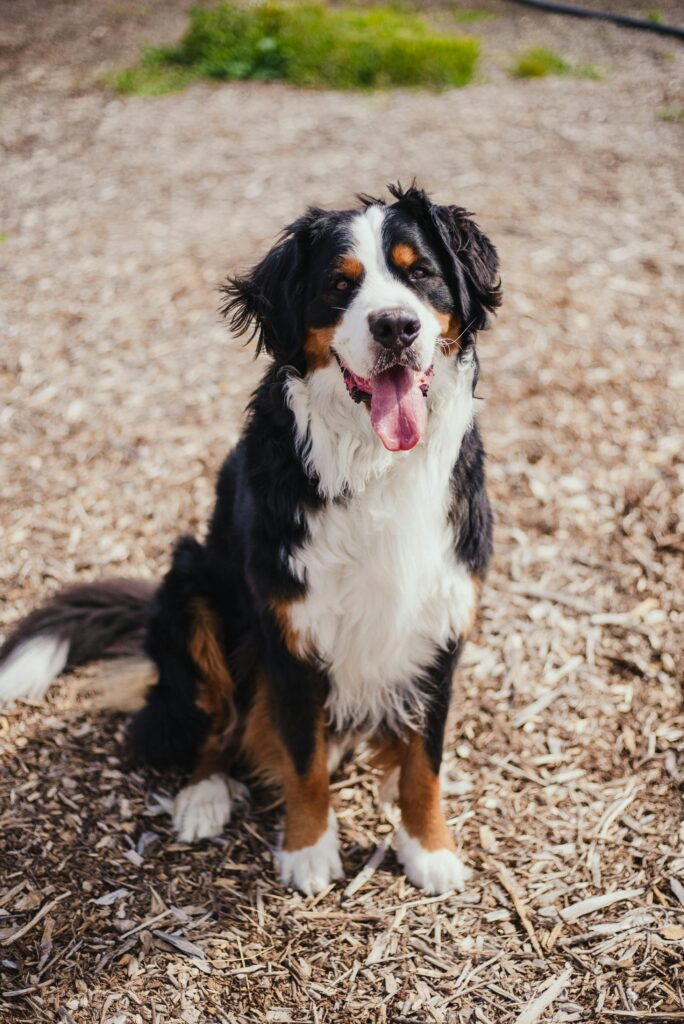
History and Function
The Bernese Mountain Dog is one of four Swiss mountain dog breeds, originally developed in the canton of Bern. These dogs served as farm helpers, pulling carts, driving cattle, and guarding homesteads. Unlike the true livestock guardian dogs such as the Estrela or Pyrenean Mountain Dog, the Bernese was a draft and droving dog, working closely with people rather than independently with livestock.
Over the last century, the Bernese has transitioned from farm utility dog to a popular family companion and show dog, valued for its striking tricolor coat and gentle temperament.
Size and Structure
Bernese Mountain Dogs are a large breed, typically weighing 80–115 pounds. They have a broad, sturdy build, suited for pulling loads but not for long-distance endurance like the Estrela. Their proportions reflect their farm origins: strong bone, deep chest, and moderate agility, but less stamina for mountain patrol compared to true livestock guardians.
Coat and Grooming
The Bernese coat is long, thick, and tricolored (black, rust, and white). It is both beautiful and functional, providing insulation in cold climates. Grooming requirements are high, as they shed year-round and experience heavier seasonal shedding. Weekly brushing is necessary, with more frequent grooming during shedding seasons to prevent matting. Regular care also helps reduce the accumulation of loose hair inside the home — a common challenge for Bernese owners.
Temperament
The Bernese is known for being gentle, affectionate, and people-oriented. They thrive on companionship and are often described as “sensitive” dogs. This temperament makes them well-suited to families, including those with children, provided the children are respectful.
They are less independent than Estrelas or Pyreneans and may not excel as property guardians. Their protective instincts exist but are usually subdued, making them more likely to welcome guests than to deter intruders.
Health and Lifespan
Health is the most serious consideration for anyone interested in a Bernese Mountain Dog. Despite their popularity, the breed suffers from a very short lifespan, averaging only 6–8 years. The most common cause of early death is cancer, particularly histiocytic sarcoma, which occurs at much higher rates in Bernese than in most other large breeds.
Other health concerns include:
- Hip and elbow dysplasia
- Bloat (gastric torsion)
- Degenerative myelopathy (a progressive spinal condition)
Compared to the Estrela Mountain Dog, the Bernese faces much more severe health challenges and has significantly reduced longevity. Prospective owners should be prepared for this reality and seek out breeders who prioritize genetic diversity and health testing.
Ideal Owner and Role
The Bernese Mountain Dog is best suited for families who want a gentle, affectionate large companion dog and are prepared for its short lifespan and heavy grooming needs. While they can perform farm work, their role today is primarily as a companion, with cart pulling and draft demonstrations preserved more as heritage activities than as daily work.
Bernese Mountain Dog FAQs
Why do Bernese Mountain Dogs have such a short lifespan?
The biggest health challenge for the Bernese Mountain Dog is cancer, especially a form called histiocytic sarcoma. This disease is unusually common in the breed and often leads to early deaths. While most large dog breeds live 10 years or more, the Bernese often lives only 6–8 years. Careful breeding for genetic diversity may help, but the risk remains high.
Are Bernese Mountain Dogs good with children?
Yes. Bernese are known for being gentle, affectionate, and patient with kids. Their large size means supervision is always necessary, but their temperament is typically very steady in family settings. They thrive when they are part of daily life and included in activities.
Do Bernese Mountain Dogs shed a lot?
Yes. The thick double coat sheds year-round and becomes especially heavy during spring and fall. Owners should expect regular brushing (at least once a week, more during shedding season) and a fair amount of loose hair in the home.
Are Bernese Mountain Dogs protective?
Bernese are loyal and may alert to strangers, but they are not natural livestock guardian dogs. Unlike breeds such as the Estrela Mountain Dog or Great Pyrenees, Bernese tend to be more welcoming than suspicious. Their protective instincts are softer, making them less reliable as guard dogs.
How much exercise does a Bernese Mountain Dog need?
Bernese are working dogs but not high-endurance breeds. They need moderate daily exercise — walks, play sessions, or cart-pulling activities. Too much strenuous activity, especially in young dogs, can harm their joints. They are happiest when active with their people but do not require the constant work of a true guardian breed.
Health Problems in Bernese Mountain Dogs
Bernese Mountain Dog Health Overview
| Health Concern | Details | Impact on Breed |
|---|---|---|
| Cancer (Histiocytic Sarcoma, Lymphoma, Mast Cell Tumors) | Extremely common; leading cause of death | ~50% of Bernese die from cancer before age 8 |
| Hip & Elbow Dysplasia | Abnormal joint development; leads to arthritis and mobility issues | High prevalence; requires health screening |
| Degenerative Myelopathy | Progressive spinal disease causing hind limb weakness | Genetic risk; carriers can be tested |
| Bloat (Gastric Dilatation-Volvulus) | Life-threatening stomach twisting | At-risk due to deep chest |
| Average Lifespan | 6–8 years | One of the shortest among large dog breeds |
The Bernese Mountain Dog is widely admired for its beauty and gentle temperament, but the breed is also one of the most medically fragile among large dog breeds. Prospective owners should understand the serious health concerns that affect this breed and how these shape its care and lifespan.
Cancer in Bernese Mountain Dogs
The single most significant health issue in Bernese Mountain Dogs is cancer, particularly histiocytic sarcoma. This aggressive cancer arises from immune system cells and is far more common in Bernese than in most other breeds. It can affect the lungs, liver, spleen, or skin and often progresses rapidly.
Studies consistently show that nearly half of Bernese Mountain Dogs die from cancer, with many diagnosed between the ages of four and eight. Other cancers, such as lymphoma and mast cell tumors, also appear more frequently in this breed compared to the general dog population.
Musculoskeletal Concerns
Like many large dog breeds, Bernese are prone to hip dysplasia and elbow dysplasia, conditions where the joints do not form correctly. These lead to pain, lameness, and arthritis. Early screening (through OFA or PennHIP) is critical when selecting a puppy, and prospective owners should confirm that both parents have certified hips and elbows.
Degenerative Myelopathy
This is a progressive spinal cord disease that can appear in older Bernese Mountain Dogs. It leads to weakness and eventually paralysis of the hind limbs. While genetic testing can identify carriers, the disease remains a concern in the breed.
Bloat (Gastric Dilatation and Volvulus)
As a large, deep-chested breed, Bernese are at risk for bloat, a condition where the stomach fills with gas and can twist. This is a life-threatening emergency requiring immediate veterinary attention. Preventative measures include feeding smaller, more frequent meals and avoiding vigorous activity right after eating.
Lifespan Considerations
The combined effect of these health issues results in a significantly shortened lifespan. Most Bernese Mountain Dogs live only 6–8 years, whereas similar-sized guardian breeds like the Estrela Mountain Dog often reach 10–12 years. This makes the Bernese one of the shortest-lived large breeds, despite its popularity.
What This Means for Owners
Prospective owners should enter into Bernese ownership with realistic expectations: the breed offers unmatched affection and beauty, but often for a much shorter time than expected. Responsible breeders are working to improve longevity through health testing and careful genetic management, but progress is slow. Families must be prepared emotionally and financially for the possibility of early health challenges.
Greater Swiss Mountain Dog (Switzerland)
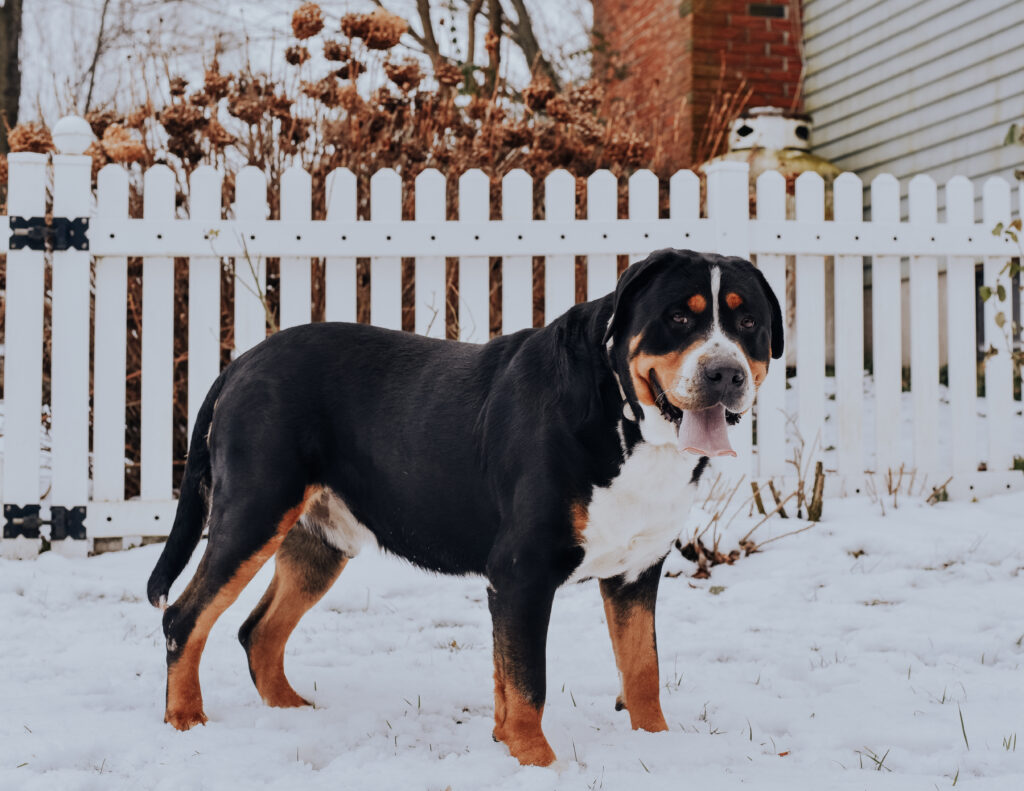
Greater Swiss Mountain Dog: Sturdy Swiss Draft and Family Dog
The Greater Swiss Mountain Dog is a powerful Swiss breed developed for draft work and guarding farms. Learn about its size, temperament, coat care, and health issues like hip dysplasia and bloat.
Target Keywords: Greater Swiss Mountain Dog, Swiss mountain dog breeds, large Swiss farm dog, Greater Swiss Mountain Dog health, Greater Swiss Mountain Dog lifespan, Swiss draft dogs
History and Function
The Greater Swiss Mountain Dog (often called “Swissy”) is the largest of the four Swiss mountain dog breeds. It was traditionally used as a draft and driving dog, pulling carts, moving cattle, and guarding farms. Unlike the Estrela or Pyrenean Mountain Dog, the Swissy was not developed as a livestock guardian but as a farm companion and worker directly managed by people.
Today, the breed is valued as a family dog and versatile worker, though it still retains its strength and ability as a cart-puller.
Size and Structure
The Greater Swiss Mountain Dog is a giant breed, with males weighing 100–140 pounds and females slightly smaller. They are heavily built, with strong bone and muscle, but less coat than the Bernese. Their structure reflects a dog bred for powerful bursts of labor rather than the independence and stamina of guardian breeds.
Coat and Grooming
The coat is short, dense, and tricolored (black, white, and rust). Grooming is minimal compared to the Bernese: weekly brushing to manage shedding is usually sufficient. They shed year-round, with heavier shedding during seasonal changes.
Temperament
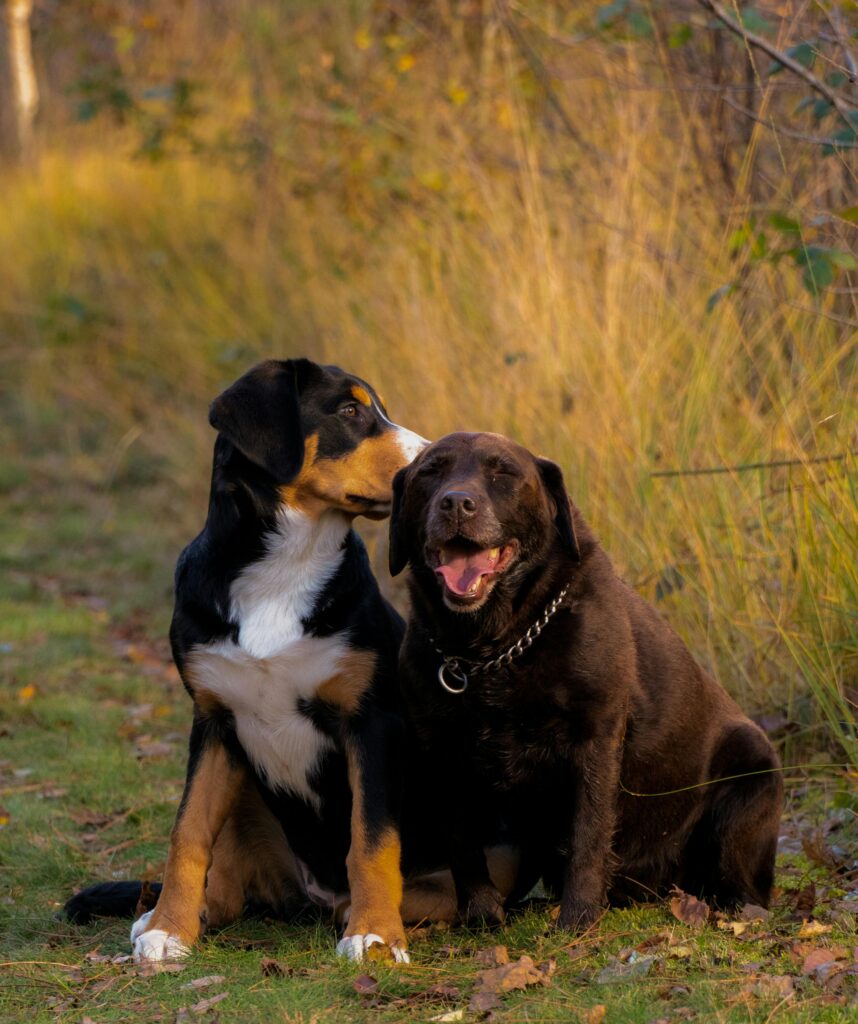
The Greater Swiss Mountain Dog is confident, steady, and loyal. They are more reserved than the Bernese, but not as suspicious or independent as livestock guardians. Their temperament reflects their role as a family protector and farm helper: alert, watchful, but generally welcoming with proper introductions.
They are known for being reliable with children and other animals when properly socialized, though their size requires supervision.
Health and Lifespan
The Swissy is healthier overall than the Bernese but still faces some large-breed concerns:
- Hip dysplasia and elbow dysplasia
- Bloat (gastric dilatation-volvulus)
- Osteochondrosis dissecans (OCD), a joint cartilage disorder seen in young dogs
Average lifespan is 8–11 years, better than the Bernese but slightly shorter than the Estrela Mountain Dog.
Ideal Owner and Role
The Greater Swiss Mountain Dog is well-suited to families who want a large, loyal companion with moderate grooming needs. They are less independent than guardian breeds, making them more adaptable to suburban or rural homes, provided they have space to exercise. Their protective instincts are present but balanced, making them trustworthy guardians without the intense suspicion of true LGDs.
Greater Swiss Mountain Dog FAQs
Are Greater Swiss Mountain Dogs good family pets?
Yes. The Greater Swiss Mountain Dog is known for being loyal, steady, and gentle with children when properly socialized. Their large size means supervision is always necessary, but their temperament is generally calm and dependable.
Do Greater Swiss Mountain Dogs shed a lot?
They have a short double coat that sheds year-round, with heavier shedding in spring and fall. Grooming needs are moderate — a weekly brushing usually keeps the coat healthy and controls loose hair.
How long do Greater Swiss Mountain Dogs live?
The average lifespan is 8–11 years, which is longer than the Bernese Mountain Dog but shorter than the Estrela Mountain Dog. With proper care and health screening, many live close to a decade or more.
What health problems affect Greater Swiss Mountain Dogs?
The main concerns include:
- Hip and elbow dysplasia (joint problems common in large dogs)
- Bloat (gastric torsion), a life-threatening stomach condition
- Osteochondrosis dissecans (OCD), a cartilage disorder in young, fast-growing dogs
Responsible breeding and careful growth management in puppies can reduce the risks.
Are Greater Swiss Mountain Dogs protective?
Yes, but in a measured way. They are alert and loyal farm dogs, originally used to guard property and cattle. Unlike livestock guardian breeds such as the Estrela or Pyrenean, they are less suspicious and more people-oriented. They make reliable family watchdogs rather than independent flock guardians.
How much exercise does a Greater Swiss Mountain Dog need?
Swissies need moderate daily exercise — walks, yard play, or working activities like cart-pulling. They are not high-energy dogs, but they do require consistent activity to stay fit and prevent weight gain.
Greater Swiss Mountain Dog Health Overview
| Health Concern | Details | Impact on Breed |
|---|---|---|
| Hip & Elbow Dysplasia | Abnormal joint development leading to arthritis and lameness | Common in large breeds; screening essential |
| Bloat (Gastric Dilatation-Volvulus) | Stomach fills with gas and twists | Life-threatening; emergency condition |
| Osteochondrosis Dissecans (OCD) | Cartilage disorder in young, rapidly growing dogs | May require surgery in severe cases |
| Average Lifespan | 8–11 years | Better than Bernese, slightly shorter than Estrela |
Pyrenean Mountain Dog (Great Pyrenees)
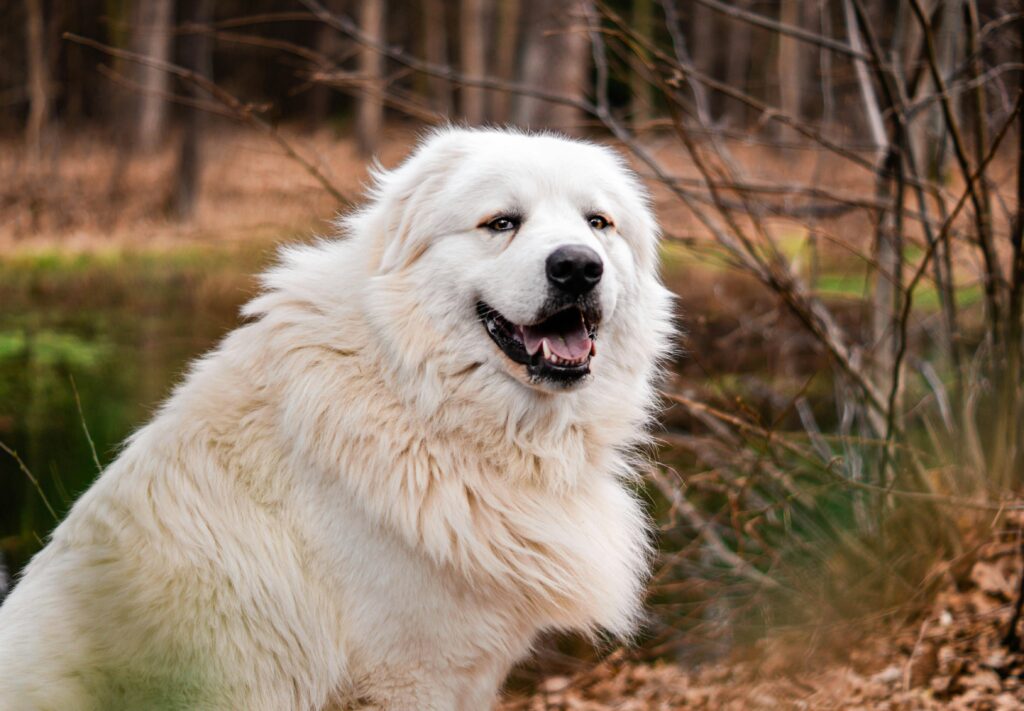
Great Pyrenees Breed Description: The Pyrenean Mountain Dog, known in the U.S. as the Great Pyrenees, is a calm livestock guardian breed. Discover its history, temperament, coat care, and common health issues.
Target Keywords: Pyrenean Mountain Dog, Great Pyrenees, livestock guardian dogs, Great Pyrenees health, Great Pyrenees lifespan, Great Pyrenees coat care, best dogs for farms, family livestock guardian dog
History and Function
The Pyrenean Mountain Dog, known as the Great Pyrenees in North America, originated in the Pyrenees mountains between France and Spain. For centuries, shepherds relied on these dogs to guard sheep and goats against wolves and bears. Like the Estrela Mountain Dog, they are true livestock guardian dogs (LGDs) — independent, calm, and capable of making decisions without constant human direction.
In modern times, Great Pyrenees continue to serve as flock guardians on farms across Europe and North America. They are also popular as family companions, especially in rural areas where their calm temperament and imposing presence provide natural protection.
Size and Structure
Great Pyrenees are a giant breed, with males typically weighing 100–120 pounds and females slightly smaller. They are tall, strong, and built for steady endurance rather than bursts of speed. Their heavy bone and deep chest reflect a dog made for guarding livestock over long hours in rough terrain.
Coat and Grooming
The coat is one of the breed’s most notable features: a thick, weather-resistant double coat that protects against cold winters and wet conditions. It is long, predominantly white, sometimes with markings of gray, tan, or badger.
Coat care requires regular brushing to prevent mats and tangles, especially behind the ears and on the feathered legs. Shedding is heavy, particularly in warm climates or during seasonal coat changes. Owners should be prepared for significant coat maintenance and regular vacuuming indoors.
Temperament
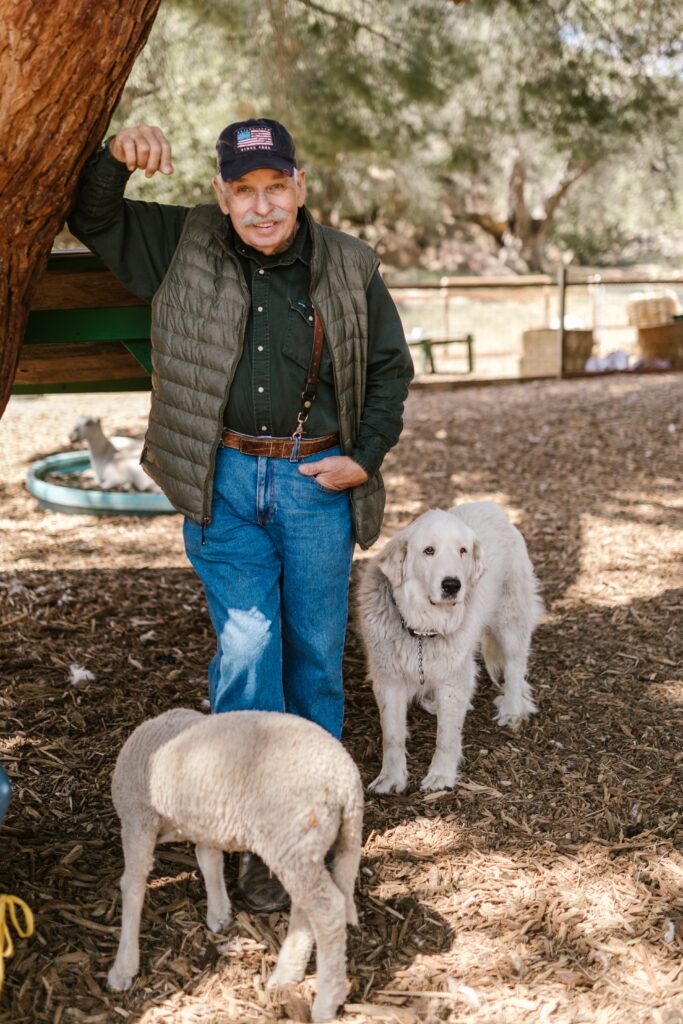
The Pyrenean Mountain Dog is known for being gentle, calm, and watchful. With family, they are affectionate and deeply loyal, often forming strong bonds with children. With strangers, they are reserved and protective, though rarely aggressive unless provoked.
As with other LGDs, they are independent thinkers and may not obey commands simply for the sake of obedience. Instead, they use judgment developed through centuries of guarding livestock without constant direction.
Health and Lifespan
Health challenges for Great Pyrenees include:
- Hip dysplasia and elbow dysplasia
- Luxating patella (kneecap issues)
- Bone cancer (osteosarcoma) in some lines
- Bloat (gastric dilatation-volvulus)
- Hypothyroidism (underactive thyroid, leading to weight gain and skin issues)
The average lifespan is 8–10 years, which is shorter than the Estrela but longer than the Bernese.
Ideal Owner and Role
The Pyrenean Mountain Dog thrives with owners who appreciate its guardian instincts and independent temperament. They are best suited to farms or rural households where they can serve a meaningful role — guarding livestock, property, or family. They can adapt to family life, but they are not well suited to apartments or densely populated urban environments due to their size, vocal nature, and protective instincts.
Great Pyrenees FAQs
Do Great Pyrenees bark a lot?
Yes. The Great Pyrenees is one of the most vocal livestock guardian dogs. Barking is central to its guardian role, used to warn predators and signal ownership of territory. In modern homes, this translates into frequent barking at night, at noises, or at perceived intrusions. Owners must be prepared for this trait — it is genetic, not simply a behavior problem.
Do Great Pyrenees roam?
Yes. Like other traditional guardian breeds, Great Pyrenees were bred to patrol wide areas of land. When not contained with secure fencing, they may roam beyond property lines in search of threats. This roaming instinct is difficult to eliminate and must be managed through fencing or supervision.
Are Great Pyrenees good with children?
Generally, yes. They are gentle, calm, and protective with children, often forming strong bonds with them. Their sheer size means supervision is important, and children must learn to respect the dog’s space.
Do Great Pyrenees make good house dogs?
They can live in the home, but they are best suited to rural or semi-rural settings where their instincts can be expressed. In small yards or suburban neighborhoods, their barking and roaming can quickly become problematic.
What health problems affect Great Pyrenees?
| Health Concern | Details | Impact on Breed |
|---|---|---|
| Hip & Elbow Dysplasia | Abnormal joint development leading to pain and arthritis | Common in large guardian breeds |
| Luxating Patella | Kneecap slips out of place | Seen in some lines; may require surgery |
| Bloat (Gastric Dilatation-Volvulus) | Stomach twisting; life-threatening emergency | At-risk due to deep chest |
| Hypothyroidism | Underactive thyroid causing weight gain and coat problems | Manageable with lifelong medication |
| Osteosarcoma (Bone Cancer) | Malignant bone cancer | Occurs in some bloodlines |
| Average Lifespan | 8–10 years | Typical for giant breeds; shorter than Estrela, longer than Bernese |
Great Pyrenees face several common large-breed concerns, including:
- Hip and elbow dysplasia
- Luxating patella (kneecap issues)
- Bloat
- Hypothyroidism
- Some cases of osteosarcoma (bone cancer)
How long do Great Pyrenees live?
The average lifespan is 8–10 years. With proper care, some may live longer, but this is typical for giant breeds.
Why are so many Great Pyrenees in rescue?
The breed’s popularity as a “gentle giant” has led to a rise in backyard breeding without regard for health or temperament. Many families adopt or buy Great Pyrenees without understanding their natural barking, roaming, and independent nature. When these instincts conflict with suburban or urban lifestyles, dogs are often surrendered. This makes education and responsible breeding especially important for this breed.
Appenzeller Mountain Dog (Switzerland)
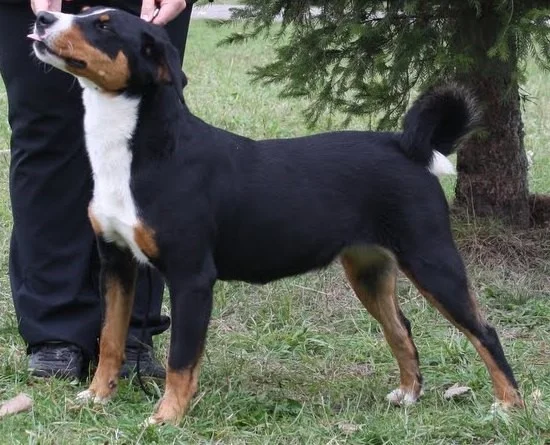
Photo Credit: Balihara Ranch
History and Function
The Appenzeller Mountain Dog is one of the four traditional Swiss mountain dog breeds, but it stands apart from its larger relatives. Originating in the Appenzell region of Switzerland, this breed was developed primarily as a herding and farm protection dog. While the Bernese and Greater Swiss were bred to pull carts and guard homesteads, the Appenzeller’s strength was its agility and sharp instincts, making it well-suited to driving cattle through steep mountain pastures.
In addition to moving livestock, Appenzellers were relied upon as farm watchdogs, known for their sharp voices and vigilance. Their willingness to bark at intruders made them invaluable in rural settings where people needed immediate warning of approaching strangers or predators. Even today, the breed’s natural tendency to sound the alarm is one of its most defining traits.
Size and Structure
The Appenzeller is a medium to large breed, typically weighing 50–70 pounds and standing 18–22 inches at the shoulder. Unlike the heavier Bernese or Swissy, the Appenzeller has a compact, athletic build, designed for speed and stamina. Its lightness on its feet makes it highly agile, capable of quick turns and bursts of energy necessary for herding livestock in challenging terrain.
Despite its smaller size, the Appenzeller is a robust, muscular dog with strong working capacity. Its structure emphasizes function over show, with a body designed to cover ground efficiently and withstand long days of work.
Coat and Grooming
The Appenzeller’s coat is short, dense, and tricolored, with a glossy outer layer and a thick undercoat that provides protection against wind and rain. Like the other Swiss breeds, its coloration is striking: a black base with rust and white markings, or occasionally a brown base in some lines.
Coat care is minimal compared to the long-haired Bernese. Weekly brushing is usually sufficient to remove loose hairs and maintain a healthy shine. Seasonal shedding is heavier, especially in spring and fall, but still easier to manage than the Bernese or Great Pyrenees. Owners should note, however, that while grooming demands are light, the breed’s energy and vocal nature require far more management than coat care does.
Temperament
The Appenzeller is best described as energetic, intelligent, and vocal. This is not a laid-back family companion like the Bernese, nor a calm guardian like the Estrela or Pyrenean. Instead, it is a high-drive working dog that thrives on activity and engagement.
They are excellent watchdogs, quick to sound the alarm at anything unusual. On a farm, this trait is highly valuable; in suburban neighborhoods, it can quickly become a nuisance. Unlike the independent Estrela or Pyrenean, the Appenzeller wants to work with people, making it highly trainable but also demanding of time and attention. Without sufficient outlets for its energy, the breed can become destructive, restless, or excessively noisy.
With families, Appenzellers can be affectionate and loyal, but they require consistent training and firm leadership. They do not tolerate boredom well and are best suited to owners who enjoy outdoor activities, sports, or farm work.
Health and Lifespan
One of the strengths of the Appenzeller is its overall health and longevity. Unlike the Bernese, which suffers from widespread cancer, the Appenzeller has remained relatively free of severe genetic bottlenecks. Average lifespan is 12–14 years, making it one of the longest-lived mountain dog breeds.
Appenzeller Mountain Dog Health Overview
| Health Concern | Details | Impact on Breed |
|---|---|---|
| Hip Dysplasia | Malformed hip joint leading to pain and arthritis | Occasional, but less common than in giant breeds |
| Eye Disorders | Cataracts or other inherited eye issues | Seen in some lines; screening recommended |
| Neurological Conditions | Rare, isolated cases reported (e.g., degenerative issues) | Not widespread in the breed |
| Average Lifespan | 12–14 years | Longest-lived of the mountain dog breeds |
Health concerns include:
- Hip dysplasia, though prevalence is lower than in the giant breeds
- Occasional eye disorders (such as cataracts)
- Rare cases of progressive neurological conditions, though these are not widespread
The combination of medium size, functional breeding, and active use has helped preserve the Appenzeller as a hardy working breed.
Ideal Owner and Role
The Appenzeller Mountain Dog is best suited for active farms and experienced working-dog owners. Its need for movement, tasks, and mental stimulation makes it thrive in settings where it can herd, guard, or participate in dog sports. Owners should appreciate the breed’s watchful and vocal nature, seeing it as an asset rather than a problem.
For those seeking a large, quiet, protective guardian, the Appenzeller will not be the right match. But for families or farmers who need a versatile, agile, and energetic herding dog, it offers exceptional ability and loyalty.
Entlebucher Mountain Dog (Switzerland)
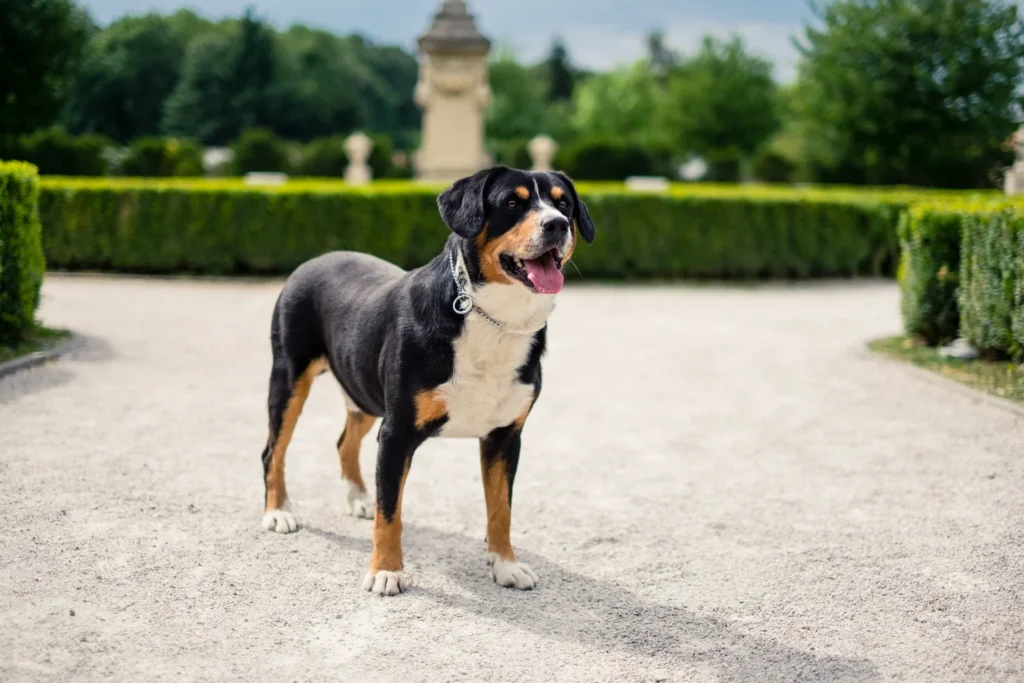
Photo Credit: Schweizersennenhunde
History and Function
The Entlebucher Mountain Dog is the smallest and most agile of the four traditional Swiss mountain dog breeds. Its origins lie in the Entlebuch valley of Switzerland, where it was developed primarily as a cattle-driving and droving dog. Unlike the Bernese and Greater Swiss Mountain Dogs, which pulled carts and guarded homesteads, the Entlebucher’s role required speed, endurance, and agility. These dogs worked in close partnership with farmers, moving cattle down narrow alpine trails to markets and valley pastures.
Their herding role shaped their temperament: unlike livestock guardian dogs such as the Estrela or Great Pyrenees, the Entlebucher was expected to respond to human direction quickly and accurately. This emphasis on cooperation, combined with their compact, athletic build, makes the Entlebucher more similar in working style to breeds like the Australian Cattle Dog or Border Collie than to its larger Swiss cousins.
Though still relatively rare outside Switzerland, the breed has earned recognition for its intelligence and versatility. In recent decades, Entlebuchers have found a place not only on farms but also in dog sports, obedience competitions, and active households. Their sharp minds and tireless energy make them excellent partners for people who want a working relationship with their dog.
Size and Structure
The Entlebucher is a medium-sized dog, typically weighing 40–65 pounds and standing 16–21 inches at the shoulder. Compact and muscular, it combines power with agility. The breed’s structure reflects its droving heritage: a longer back, strong legs, and flexible joints that allow it to make quick turns and cover ground efficiently.
Unlike the heavy-boned Bernese or Swissy, the Entlebucher’s build emphasizes endurance and agility rather than raw pulling strength. Its smaller size makes it physically easier to manage, but its high activity level requires an owner with the time and energy to keep up.
Coat and Grooming
The Entlebucher’s coat is short, dense, and double-layered, designed to resist weather and provide insulation in variable climates. Its classic tricolor pattern — black base with rust and white markings — mirrors that of the other Swiss breeds.
Grooming needs are minimal compared to long-coated breeds like the Bernese or Great Pyrenees. Weekly brushing is usually sufficient, with more frequent grooming during seasonal shedding. While shedding is consistent year-round, it is manageable with routine care. The coat is largely self-cleaning, which reflects its heritage as a farm dog expected to work in all conditions with little fuss.
Bathing is needed only occasionally, as over-washing can strip the natural oils from the coat. Owners should also maintain regular nail trimming, ear cleaning, and dental care, as with any active working breed.
Temperament
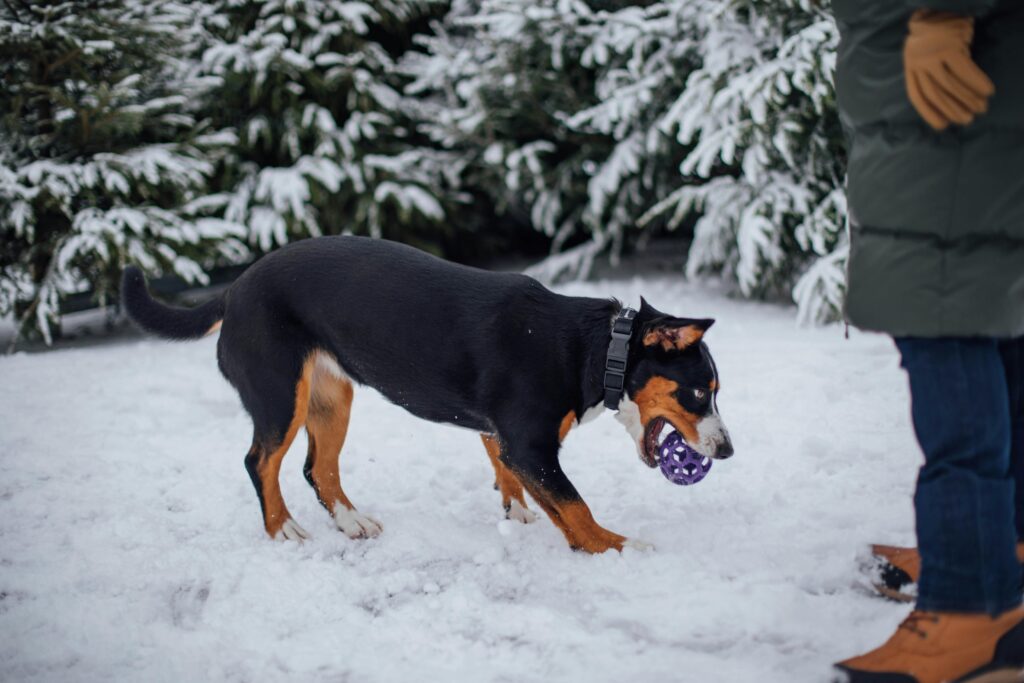
The Entlebucher is alert, intelligent, and energetic. Its herding heritage means it is a driven, task-oriented breed that thrives on meaningful work. Unlike the independent Estrela or Pyrenean Mountain Dogs, which were bred to make decisions on their own, the Entlebucher was designed to work closely under human direction. This makes it highly trainable in skilled hands but potentially frustrating for owners expecting a laid-back companion.
They are often described as loyal and affectionate with their families, forming close bonds and showing strong devotion. However, they can be reserved or suspicious with strangers, making them reliable watchdogs. With children, they are generally good, but supervision is important, as their strong herding drive may lead them to nip at heels or attempt to control play.
Entlebuchers require consistent training, firm leadership, and mental stimulation. Without adequate outlets, they may develop problem behaviors such as excessive barking, digging, or destructive chewing. They excel in structured environments such as farms, sport training, or households that actively engage with their energy and intelligence.
Health and Lifespan
The Entlebucher is generally healthier than many larger mountain dog breeds, but there are still concerns to be aware of:
- Hip Dysplasia: Present in the breed, though less common than in giant dogs. Responsible breeders screen breeding stock.
- Progressive Retinal Atrophy (PRA): An inherited condition leading to gradual vision loss and eventual blindness. Genetic testing is available to help avoid producing affected dogs.
- Spinal Disorders: Rare cases of hemivertebrae (abnormally shaped vertebrae) and other spinal issues have been reported. These can impact mobility in severe cases.
- Bloat (Gastric Dilatation-Volvulus): Less common than in giant breeds, but still possible due to chest structure.
With careful breeding and management, the Entlebucher has an average lifespan of 11–13 years, which is relatively long for a working breed. This makes them more comparable in longevity to the Appenzeller than to their larger Swiss cousins.
Ideal Owner and Role
The Entlebucher Mountain Dog is best suited for active, experienced dog owners who want a partner in work, training, or sports. They thrive when they have a clear role, whether herding cattle, competing in agility, or accompanying owners on daily outdoor adventures.
They are not a passive companion breed. Without guidance and purpose, their energy and intelligence can lead to frustration for both dog and owner. They fit best in rural or highly active households, where their natural talents can be appreciated.
For the right family, the Entlebucher offers a rare combination: the devotion and presence of a Swiss mountain dog in a smaller, more manageable size, combined with the intelligence and agility of a true herding dog.
Entlebucher Mountain Dog FAQs
Are Entlebucher Mountain Dogs good family dogs?
Yes, but only in active households. The Entlebucher Mountain Dog is affectionate and loyal with its family but has a very high energy level and strong herding drive. Families with children must supervise interactions, as the breed may attempt to herd by nipping at heels. They do best with structured training and consistent boundaries.
Do Entlebucher Mountain Dogs bark a lot?
Yes. Like the Appenzeller, Entlebuchers are naturally vocal farm dogs. Barking was essential to their historical role as watchdogs and drovers. While they are not as loud as a Great Pyrenees, owners should expect frequent barking when the dog is alerting to unusual activity.
How much exercise does an Entlebucher Mountain Dog need?
A lot. The Entlebucher is one of the most active Swiss mountain dog breeds, requiring at least 1–2 hours of vigorous exercise daily. This should include both physical activity (runs, hikes, farm work) and mental stimulation (training, agility, or problem-solving tasks). Without this, they can become destructive or restless.
What health problems affect Entlebucher Mountain Dogs?
The Entlebucher is generally a healthy breed, but a few inherited concerns exist.
Entlebucher Mountain Dog Health Overview
| Health Concern | Details | Impact on Breed |
|---|---|---|
| Hip Dysplasia | Malformed hip joint leading to pain and arthritis | Present but less common than in giant breeds |
| Progressive Retinal Atrophy (PRA) | Inherited eye condition causing vision loss | Genetic testing available to reduce risk |
| Spinal Disorders | Rare cases of hemivertebrae or related spinal issues | May affect mobility in severe cases |
| Bloat (Gastric Torsion) | Stomach twisting; less common but possible | Life-threatening if untreated |
| Average Lifespan | 11–13 years | Long-lived compared to other Swiss breeds |
How long do Entlebucher Mountain Dogs live?
On average, 11–13 years, making them one of the longest-lived Swiss mountain dog breeds. This longevity reflects their medium size and relatively diverse gene pool compared to the heavily bottlenecked Bernese Mountain Dog.
Are Entlebucher Mountain Dogs protective?
Yes, but their protection style is more watchdog than guard dog. They are quick to bark and alert their families but are not bred to confront predators the way Estrelas or Great Pyrenees are. Their herding heritage makes them more assertive with livestock and people than outright defensive guardians.
Mountain Dog Breeds: Complete Comparison Chart
| Breed | Origin | Primary Function | Size | Coat & Grooming | Temperament | Health Concerns | Average Lifespan | Best Suited For |
|---|---|---|---|---|---|---|---|---|
| Estrela Mountain Dog | Portugal | Livestock Guardian Dog | 90–130 lbs | Long or short coat; moderate grooming; heavy seasonal shedding | Loyal, protective, independent yet family-bonded | Hip/elbow dysplasia, DCM, occasional bloat | 10–12 years | Farms, rural families, experienced large-dog owners |
| Bernese Mountain Dog | Switzerland | Draft work, droving, companion | 80–115 lbs | Long tricolor coat; heavy grooming, year-round shedding | Gentle, affectionate, people-oriented | Cancer (esp. histiocytic sarcoma), hip/elbow dysplasia, bloat, degenerative myelopathy | 6–8 years | Families wanting a gentle large companion, aware of short lifespan |
| Greater Swiss Mountain Dog | Switzerland | Draft & driving work, farm guard | 100–140 lbs | Short tricolor coat; moderate grooming | Steady, loyal, confident | Hip/elbow dysplasia, bloat, OCD in young dogs | 8–11 years | Families seeking a loyal watchdog with moderate care needs |
| Great Pyrenees (Pyrenean Mountain Dog) | France/Spain | Livestock Guardian Dog | 90–120 lbs | Long double coat; heavy grooming, mats possible | Calm, gentle, protective, highly vocal | Hip/elbow dysplasia, luxating patella, hypothyroidism, bloat, bone cancer | 8–10 years | Farms, rural homes, owners who can manage barking & roaming |
| Appenzeller Mountain Dog | Switzerland | Herding, watchdog, versatile farm dog | 50–70 lbs | Short tricolor coat; easy grooming | Energetic, vocal, confident | Hip dysplasia, cataracts, rare neurological issues | 12–14 years | Active farms, experienced working-dog homes |
| Entlebucher Mountain Dog | Switzerland | Cattle droving, herding, watchdog | 40–65 lbs | Short tricolor coat; easy grooming | Intelligent, loyal, high-energy, strong-willed | Hip dysplasia, PRA, rare spinal disorders, bloat | 11–13 years | Active, experienced owners; farms or sport homes |
Conclusion
Mountain dog breeds share a reputation for strength, loyalty, and rugged endurance, but their differences are significant. Each was shaped by the demands of its homeland — from the Portuguese shepherd’s need for a wolf-fighting guardian, to the Swiss farmer’s need for cattle drivers and cart pullers, to the Pyrenean shepherd’s reliance on calm protectors in the mountains.
- The Bernese Mountain Dog offers unmatched gentleness and beauty but is hampered by severe health problems and a short lifespan.
- The Greater Swiss Mountain Dog provides steady loyalty and family protection with moderate grooming needs, though joint issues and bloat remain concerns.
- The Great Pyrenees is a true livestock guardian, calm and devoted, but also a notorious barker and roamer, often misunderstood in non-rural homes.
- The Appenzeller and Entlebucher Mountain Dogs bring agility, longevity, and intelligence, but their high energy and vocal nature make them best suited to farms or very active homes.
- The Estrela Mountain Dog, one of the oldest livestock guardian breeds, stands out for its balance: hardy health, functional build, protective instincts, and a longer lifespan than many giants.
For families and farmers seeking a guardian capable of true work but also deeply bonded to its people, the Estrela Mountain Dog represents one of the most authentic and enduring choices. It is not a breed for every household, but in the right setting, it combines the loyalty of a family dog with the resilience of a working guardian: a rare balance among the mountain breeds.
Comments +